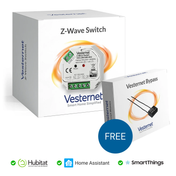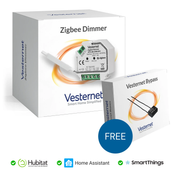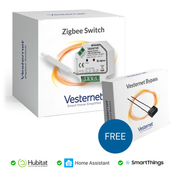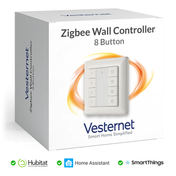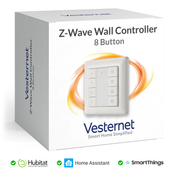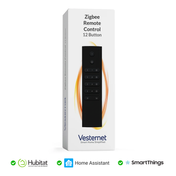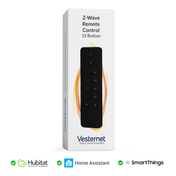
Z-Wave, Zigbee & WiFi Lock & Access Controls are a crucial element to any safety and security monitoring that you wish your Smart Home system to do.
Smart Access Control Systems and Smart Locks give you a much more convenient way of securing your home's doors, gates and garage access. They allow you to remotely control access and monitor who is coming and going from your home.
Manufacturers of Z-Wave, Zigbee & WiFi Lock & Access Controls produce them in several formats, replacement locks (where the entire lock is swapped for a Smart version), devices to control existing electronic locks, devices to control motorised gates, doors and shutters and finally devices to facilite access such as intercoms and keypads.
Choosing the right Lock & Acess Control between manufacturers can be a little difficult as some will offer more advanced capabilities and others will offer simpler functionality, often at a cheaper price. Remember that you can mix and match manufacturers on the same system as they are all compatible - more information can be found in our Understanding Compatibility guide.
This guide explains what the different types of device are used for and gives extra details to help select between the manufacturers.
Locks & Access Controls
Firstly, most Lock & Access Controls are "actuators" - meaning that they physically "do something". Things like intercoms and keypads though tend to be thought of more as sensors, rather than actuators. More information on actuators and sensors is available in our Getting Started guide.
Replacement Locks - Z-Wave | Zigbee | WiFi
These are pretty self-explanatory - your existing lock is removed and replaced with a Smart version!
Replacement Locks - things to think about:
- Lock Type - Is it a multi-point, deadbolt, or latch type? These will all require different types of replacement lock.
- DIY or DIYnot - Locks can be complicated to replace so you need to be confident this would be a job that you can handle yourself. You don't want to strip your front door down and then find that you can't install the replacement lock after all and worse still, find that you can't put the door back together again either!
- Operation - How will the Smart Lock operate? Will it work how you think it will? For example most multi-point locking doors require the handle to be lifted first in order to engage the locking mechanisms in place and the actual lock simply locks the handle in place, preventing it from being moved. This means that the Smart Lock can't actually lock the door until the handle is raised first.
- To Key or Not To Key - Keyless locks might sound very secure, but what happens if the Smart Lock doesn't work, the battery goes flat at an inopportune moment or you forget the code? Having a key to fall back on could be very handy!
- Smart Home Network - How good is your Smart Home Network? Whether it's Z-Wave, Zigbee, WiFi or something else, network range and reliability will be crucial to ensure that your Smart Lock staus Smart!
- Information - More information about these issues and other things to consider is available in our Smart Home Security and Smart Home Emergency guides.
Adding Control To Existing Locks - Z-Wave | Zigbee | WiFi
These ingenious devices can be retrofit to your existing locks to add Smart control. Typically this might involve replacing the lock barrel or making some minor modification to the existing lock barrel or handle.
Adding Control To Existing Locks - things to think about:
- Lock Suitability - Typically these types of device require the lock barrel replacing or modifying. This isn't always possible so it's worth checking beforehand that the device is suitable for your lock!
- DIY or DIYnot - Locks can be complicated so you need to be confident this would be a job that you can handle yourself. You don't want to strip your front door down and then find that you can't modify the lock succesfully after all and worse still, find that you can't put the door back together again either!
- Operation - How will the Smart Lock operate? Will it work how you think it will? For example most multi-point locking doors require the handle to be lifted first in order to engage the locking mechanisms in place and the actual lock simply locks the handle in place, preventing it from being moved. This means that the Smart Lock can't actually lock the door until the handle is raised first.
- To Key or Not To Key - Keyless locks might sound very secure, but what happens if the Smart Lock doesn't work, the battery goes flat at an inopportune moment or you forget the code? Having a key to fall back on could be very handy!
- Smart Home Network - How good is your Smart Home Network? Whether it's Z-Wave, Zigbee, WiFi or something else, network range and reliability will be crucial to ensure that your Smart Lock staus Smart!
- Electrical Works - Some devices may require electrical works, for example to replace an electro-magnetic strike plate or to add a Smart device to the existing electro-magnetic strike plate. You should be comfortable with undertaking this type of work!
- Information - More information about these issues and other things to consider is available in our Smart Home Security and Smart Home Emergency guides.
Motorised Gates, Doors & Shutters - Z-Wave | Zigbee | WiFi
Motor Modules are similar to Relays as they have switch contacts, but have been designed specifically to control motors in things like gates, motorised doors and shutters. They allow the Module to be calibrated so that it knows the position of the motor, or rather, what it is controlling - so it can know if a gate is open, closed, 50% open etc, allowing you to have it open or close to preset positions.
Motorised Gates, Doors & Shutters - things to think about:
- AC Motors - Most Motor Modules are designed to control AC mains (230V AC) motors.
- Neutral - Like Relays, AC Motor Modules also need Neutral. Check that you have Neutral available.
- DC Motors - Motors using a DC supply often use a different method to reverse the motor's direction, called "Polarity Reversal" and these need a special Motor Module that is specifically designed for this type of cointrol.
- Physical Installation - While Motor Modules are small and in fact are getting smaller all the time, they still need a reasonably deep pattress (back-box) for installation to allow room for heat dissipation and wiring to enter and exit safely. Check our our guide on physical installation of a Module for further information.
- Information - More information about these issues and other things to consider is available in our Climate & Comfort guide.
Keypads & Intercoms - Z-Wave | Zigbee | WiFi
Intercoms and keypads can add a hint of class to your Smart Home system, as well as obviously providing enhanced security. Keypads can typically be used for disarming alarm systems, unlocking doors, or even triggering Scenes - for example a PIN code for the gardener might open the garden gate, unlock the tool storage shed and temporarily deactivate the garden watering sprinkler system.
Keypads & Intercoms - things to think about:
- Location, Location, Location - Consider where you would mount an Intercom or Keypad. Typically an Intercom will provide the doorbell push button so this needs to be located in clear sight of the front door.
- Smart Home Network - How good is your Smart Home Network? Whether it's Z-Wave, Zigbee, WiFi or something else, network range and reliability will be crucial to ensure that your Intercom or Keypad works reliably, especially as it's mounted outside your house where you might not have as good coverage as inside!
- Electrical Works - Some devices may require electrical works, for example an Intercom will typically need a power supply, or perhaps an Ethernet cable routing back to your Internet router. You should be comfortable with undertaking this type of work!
- Information - More information about these issues and other things to consider is available in our Smart Home Security and Smart Home Emergency guides.
Getting Help and Advice
Hopefully this guide has helped clarify what options are available, what the different types of Z-Wave, Zigbee & WiFi Lock & Access Controls do, and shown the comparison between manufacturers. If you need any further help or advice, contact Vesternet and we will do our best to answer all your questions.


